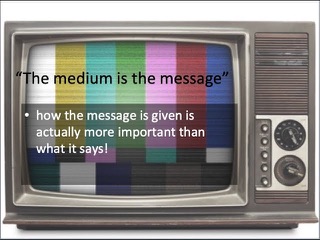
Overcoming the dominance of right-wing media in low-population rural American states requires a multifaceted approach.
Professor Marshall McLuhan uses the term "message" to signify content and character. The content of the medium is a message that can be easily grasped and the character of the medium is another message which can be easily overlooked. McLuhan says "Indeed, it is only too typical that the 'content' of any medium blinds us to the character of the medium". For McLuhan, it was the medium itself that shaped and controlled "the scale and form of human association and action". Taking the movie as an example, he argued that the way this medium played with conceptions of speed and time transformed "the world of sequence and connections into the world of creative configuration and structure". Therefore, the message of the movie medium is this transition from "lineal connections" to "configurations." Extending the argument for understanding the medium as the message itself, he proposed that the "content of any medium is always another medium" – thus, speech is the content of a writing, writing is the content of print, and print itself is the content of the telegraph.
The keys are to address all the structural and cultural factors at play.
-
Investment in Progressive Media Outlets: Supporting the establishment and growth of progressive media outlets, including radio stations, podcasts, and online platforms, is crucial. This may involve financial investments, grassroots organizing, and collaborative efforts among progressive organizations to amplify their voices in these areas. Community Engagement and Education: Engaging with communities in rural areas to understand their needs and concerns and providing platforms for dialogue and education on progressive values and policies is essential. This could involve initiatives such as town hall meetings, community radio programs, and outreach campaigns to foster understanding and build trust.
-
Digital and Social Media Strategy: Leveraging digital and social media platforms to disseminate progressive messaging and reach audiences in rural areas is vital. Investing in targeted advertising, content creation, and grassroots organizing efforts online can help counterbalance the influence of traditional right-wing media channels. Support for Local Journalism: Strengthening local journalism by supporting independent newspapers, online news outlets, and community radio stations can help diversify the media landscape in rural areas. By providing accurate and comprehensive coverage of local issues and perspectives, these outlets can offer an alternative to the partisan narratives propagated by right-wing media.
-
Civic Engagement and Voter Mobilization: Empowering rural communities through civic engagement and voter mobilization efforts is essential for building political power and challenging the dominance of right-wing forces. This includes voter registration drives, education on voting rights and procedures, and efforts to increase voter turnout in elections at all levels of government. Coalition Building and Solidarity: Building alliances with progressive organizations, community groups, labor unions, and other stakeholders in rural areas can amplify collective voices and strengthen advocacy efforts. By working together across diverse constituencies, progressives can more effectively challenge the influence of right-wing media and advance shared goals for social and economic justice.